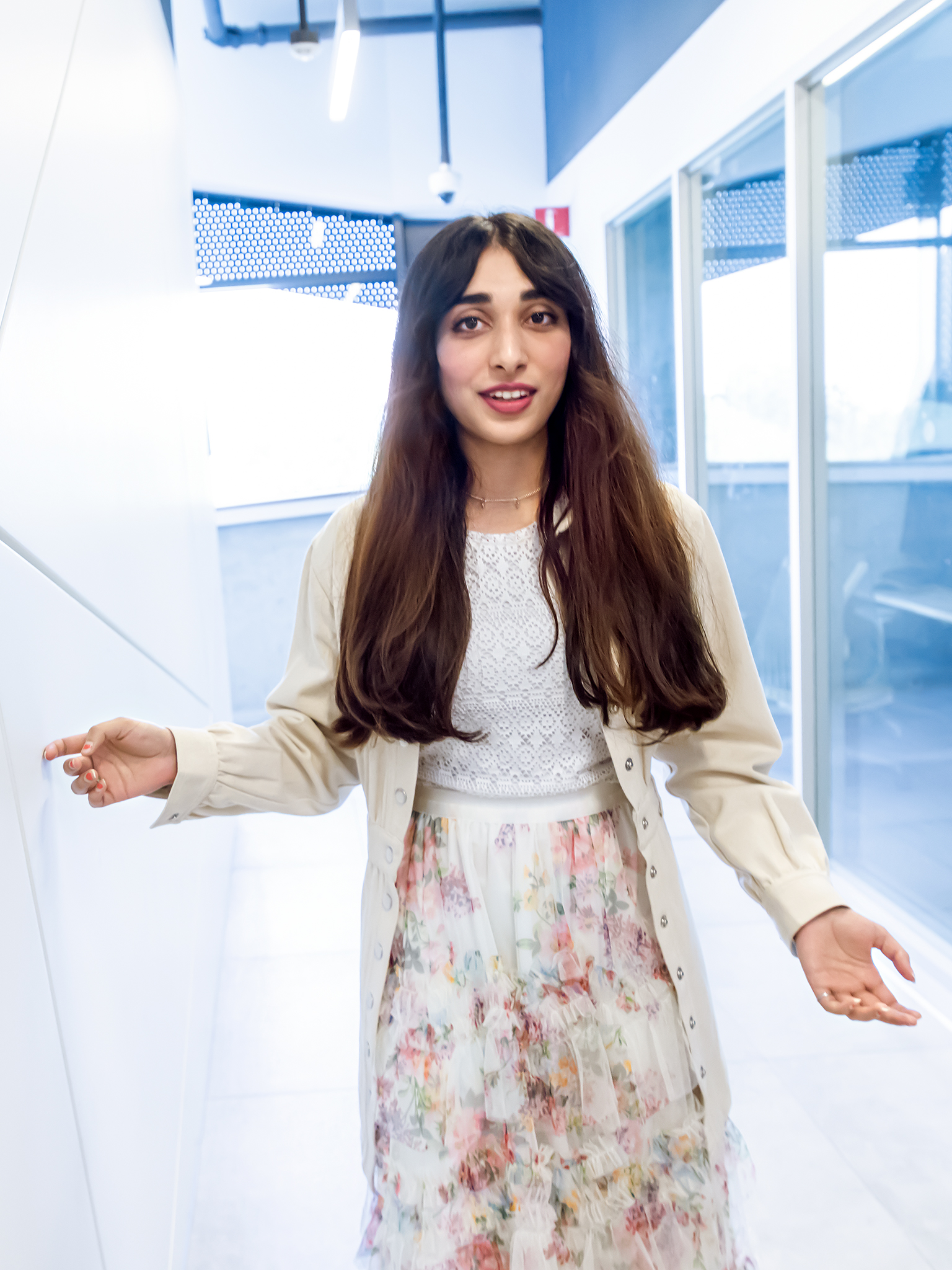Balancing Act
by Moira MacDonald
photography by Horst Herget
At York University’s Lassonde School of Engineering, a quiet revolution is underway. In just six years, number of women students has increased by about a third. The school’s equity, diversity and inclusion efforts, including targeted recruitment of underrepresented students, advance York’s long-term goal of a much stronger gender balance in engineering. This vision is realized every day through hands-on learning, outreach to young women, and a supportive community focused on getting – and keeping – more women in science, technology, engineering and math (STEM) fields.
Third-year computer engineering student Aleeya Irshad’s story is a window into this changing landscape. Encouraged by family and teachers who nurtured her love of science, she graduated from high school in Woodbridge, Ont., after building and launching two apps on the Google Play store. With that confidence behind her, she arrived at York expecting to find plenty of other women who shared her interests, only to discover how few there actually were. “I thought I’d see more women,” she says. “That really wasn’t the case.”
She graduated from high school after building and launching two apps on the Google Play store
Irshad’s experience is hardly unique; it mirrors national numbers that point to a persistent lack of representation. While women now account for close to 60 per cent of all university students in Canada, they make up less than a third of STEM workers, with female representation in disciplines such as computer and software engineering hovering at just 11 to 12 per cent across Ontario campuses. The problem, experts say, is not a shortage of talent but the complex, systemic barriers embedded in every level of the STEM pipeline, from early education to research and leadership.

As former federal science minister Kirsty Duncan, author of The Exclusion Effect, observes: “While women have come a long way in science, there is still far to go. They remain under‑represented, under‑paid, under‑published, and under the shadows of male scientists who are assumed, without evidence, to have innate capacities that women lack.”
That imbalance has galvanized change at York. Since Jane Goodyer became dean in 2018, the Lassonde School has doubled undergraduate enrolment of women, with women now representing more than 20 per cent of all engineering students, up from 15.5 per cent just a few years ago. Goodyer credits this growth to both bold leadership and programs designed to dismantle barriers. “We get the best solutions when we bring in different perspectives,” she says.
One key driver is York’s k2i (“kindergarten to industry”) academy – a flagship outreach program designed and tested by Lassonde that exposes girls and under-represented students to STEM from the earliest grades. Partnering with school boards, industry leaders and community organizations, k2i has directly engaged thousands of students.
This past year, women accounted for more than half of the co-op placements in k2i’s work-integrated learning pathways. The program’s emphasis on hands-on, real-world skills and inclusion is now considered a prototype for other Canadian universities looking to boost diversity.
They remain under-represented, under-paid, under-published, and under the shadows of male scientists who are assumed, without evidence, to have innate capacities that women lack
The school also launched Canada’s first fully work-integrated degree in digital technologies in 2023: this program allows students to earn credits as they learn with direct industry experience. The hope is that this program will further open doors for first-generation and equity-deserving students while reducing barriers related to cost and access.
But it’s not just recruitment; it’s retention. Institutions across Canada struggle to keep women and other equity-deserving students in STEM, especially through the critical first year. In response, Lassonde has pioneered a “block model” approach to the first-year engineering curriculum, delivering key concepts in focused, intensive blocks rather than the traditional multi-tasking format. This shift has resulted in a 70-per-cent reduction in first-year failure rates, a 108-per-cent increase in top grades, and a 45-per-cent rise in students completing academic requirements on time. Student stress has dropped by nearly half, and the effect is strongest for women and racialized students.
“Retention isn’t just a numbers game,” Goodyer says. “It’s about community and supporting people all the way through.”

Improvements include an early-warning dashboard that allows academic advisers to spot students needing extra help. Programs such as PASS (Peer Assisted Study Sessions) and mentorship targeted at women in first-year cohorts also support these retention gains.
The school’s Women in Science and Engineering (WISE) York chapter cultivates both community and hands‑on experience through initiatives such as the annual ElleHacks hackathon – Canada’s largest all‑female and non‑binary coding event – along with peer advising and leadership training. “It’s amazing seeing younger girls get involved,” says Pritumi Patel, WISE’s vice‑president and a third‑year York computer‑science student from Uganda. “We get to see them bringing new energy and ideas.”
Representation matters not just in labs. It’s about who tells the story and how history gets written
York’s broader Decolonizing, Equity, Diversity and Inclusion (DEDI) strategy reinforces these efforts. It has embedded measurable benchmarks and equity leadership into hiring, research, teaching, and everyday campus life, turning equity goals into practice across faculties.
Initiatives to change attitudes extend from the classroom to the wider community. Biology professor Dawn Bazely – recipient of the Sandford Fleming Medal for excellence in science communication – has championed scientific literacy and public engagement, organizing “editathons” to expand Wikipedia entries for Canadian women in science.
“Representation matters not just in labs,” Bazely says. “It’s about who tells the story and how history gets written.”
Still, there’s ground left to cover. York’s latest Measuring Success report notes that while retention and graduation rates for women in STEM have climbed steadily over the last three years, parity remains a work in progress. This is consistent with national trends. At Lassonde, staff and students say the culture is changing. Options for mentorship, co-op placements and support are greater than ever.
For Irshad, the goal is clear: women’s place in STEM should be fully recognized and reflected. “I want it to be normal for women to see themselves in engineering and science so the next generation doesn’t feel out of place,” she says.
That objective looms closer as York’s community expands, support networks grow and more female students enter the field each term. Yet one truth remains: success in STEM still means working to be seen. “We’ve got to prove ourselves constantly,” Patel says. “I want that to change.”
Lassonde is ready to meet the challenge. For women entering STEM now and in the future, the balance of the equation is shifting. ■